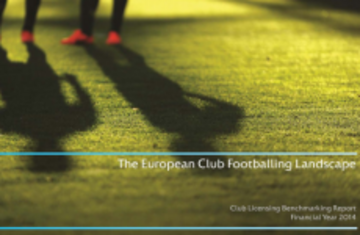EACH YEAR, UEFA release their ‘club licencing benchmark report’.
It is an overview on the overall financial health of European football, detailing the health of Europe’s thirty biggest football clubs and 15 biggest leagues.
Within the report’s pages we find nuggets such as Spurs’ €78million profit in 2014 being the biggest annual profit by any football club in history.
However, as I sat down with the 117-page report on Wednesday, my interest was in assessing the comments on League of Ireland football. It’s pretty much the only source of factual information about the state of the nation’s game.
It’s free and is available here.
In time-honoured tradition, here are seven things UEFA told us about our league this week:
1. There’s some good news
We have Europe’s most competitive – or unpredictable – league, with eight different champions over the past decade. We also experienced mild growth of 0-5% in 2014. Maybe not staggering, but many Eastern European leagues are in financial decline.
However, the average club growth in Europe is now 9.5% year on year with revenue doubling over the past decade, so we’re not keeping pace and the gap to the richest leagues is growing.
2. Revenue
The average revenue across the 12 Premier Division clubs was €900,000 across 2014 — placing us in the bottom tier of European leagues. As a contrast, Celtic generates €1,000,000 from each home match.
Perhaps the starkest indicator of the challenge faced by small clubs and league is that the revenue across the Premier League is greater than the combined revenue of the leagues ranked seventh to 54th in Europe.
The growing gap between the top leagues and the rest is a recurring theme within the report. Even within this elite group, twelve of Europe’s richest 30 clubs are Premier League sides.
3. Profit and loss
The report tells us that while one LOI club made an operating profit of 10% relative to revenue in 2014, eight of the twelve Premier Division clubs made operating losses — four losing 20% or greater relative to their revenue.
Taking the €900,000 average revenue figure from point 2, it suggests four clubs lost over €150,000 each last season.
4. Wage bill
The aggregate wage bill for the league is €6million, an average of €500,000 per club and approximately 58% of total revenue in the league.
What’s worrying is that UEFA’s report indicates that a couple of clubs may have breached salary cost protocol in 2014, with greater than 70% of their revenue going on wages.
5. Transfer fees and compensation
4% (Approximately €400,000) of total revenue across the league came from transfer fees, sell-on bonuses, training compensation and solidarity payments. I
It’s a small return for a league that continues to export our best players. Other leagues which have strong neighbouring leagues are pulling in far higher revenue from international transfers, Portugal leading the way with transfer returns equalling 75% of revenue.
6. Income broken down
The league income breakdown is 15% UEFA prize money, 34% gate receipts, 38% commercial and sponsorship activities, and 18% from other sources.
We are one of the few leagues with 0% of revenue due to domestic TV rights, which UEFA identifies separately (so it’s not included in the 18%). It’s a staggering and glaring gap when we compare it to other leagues, particularly in western Europe.
7. Gate receipts
Gate receipts contribute 34% of revenue and we share the privilege of being western Europe’s most reasonable match ticket, alongside Portugal and Iceland.
However we saw a drop – though no more than 5% – in attendances from 2013 to 2014. This is a worry given the huge increases at Dundalk and Cork City games in 2013, suggesting attendances across the remaining ten clubs were down significantly.
There was an overall attendance drop of 3% across Europe.
A couple of weeks after I – and others – criticised the lack of figures in the Conroy Report, the UEFA benchmarking report presents a number of concerns.
Losses are back, crowds have slightly dropped and while there is growth, we are falling further behind higher ranked leagues.
Openness on the part of clubs, the National Association and other stakeholders within the game is absolutely vital to ensure the trends are more positive in the next, and subsequent, reports.








Sure Huggins prob has a few quid in Wiiliams anyway
@Brian Les: Are they even real people?
Great final, and delighted that Williams won. Nice guy as well, and hard to believe that it’s 15 years since he won his last final beating our Ken.
@Aging Lothario: Ken Barlow?
Great game. Williams showed some bottle in that last frame having missed a pink for the match in the previous frame. Delighted for him, likeable guy also.
Delighted for him. Great champion.
Fair play Mark Williams! Absolutely chuffed. Inspirational ! Brilliant final.
Hope he goes to on to win it! Looking good at the moment
He arrived with a towel on to the press conference too as promised haha
Delighted for him!
More entertaining than most MNF as sky called it